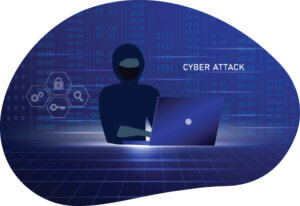Assessing the Situation
In a stark reminder of the vulnerabilities even the largest companies face, CDK Global recently fell victim to a devastating ransomware attack. It’s suspected, the hackers managed to infiltrate the company’s main servers and all of their backups, rendering critical systems inoperable and leaving the organization scrambling to regain control of their and their customers data.
The Attack
69% of all ransomware attacks start with a phishing campaign, according to the latest cybersecurity reports (proofpoint). If CDK fell victim to a phishing campaign, it would have been well coordinated campaign, targeting employees with sophisticated emails designed to look legitimate. With as large as CDK is, and the number of services they offer this campaign could have hit any of the segments of their organization. Once the hacker gained access, they would have quickly escalated their privileges or will often look to their next victim and work their way up the organizations structure, eventually taking over the company’s main servers. The ransomware then encrypted all critical data, including customer information, financial records, and proprietary business documents. To add to the company’s woes, the hacker, suspectedly, also managed to encrypt all backup files, leaving the organization with no immediate way to restore their systems.

Immediate Response: Damage Control
The first step that CDK would have taken is to isolate the infected system to prevent further spread of the ransomware. Cybersecurity experts would have been brought in to assess the extent of the breach and to attempt to decrypt the data. Unfortunately, given the sophistication of modern ransomware, these efforts often prove to be futile without the decryption key held by the attackers.
Negotiations and Ransom
CDK would have faced the difficult decision of whether to pay the ransom. While paying does not guarantee the return of their data, some organizations see it as the quickest way to resume operations. Often times companies have to weigh the cost of the ransom against the potential losses from prolonged downtime. Based on the time that CDK Global has been down, it’s suspected they chose not to negotiate and are relying on cybersecurity experts to attempt to decrypt the servers.

Steps to Recovery: Rebuilding
Regardless of the outcome of the ransom negotiations, a company would need to take significant steps to recover from the attack:
- System Restoration: If the decryption key is obtained, the first priority will be to restore the systems from the encrypted state. This process can take days or even weeks, depending on the amount of data and the complexity of the IT infrastructure.
- Strengthening Cybersecurity: To prevent future attacks, a company would conduct a thorough audit of their security measures. This includes implementing multi-factor authentication, regular phishing training for employees, and deploying advanced threat detection systems.
- Data Segregation and Encryption: Segregating sensitive data and ensuring it is encrypted both in transit and at rest can mitigate the damage from future breaches. Solutions like GiraffeDoc offer secure file sharing and data management capabilities that could be crucial in preventing unauthorized access to sensitive information.
- Regular Backups: Moving forward, maintaining regular, secure, and separate backups is essential. These backups should be tested regularly to ensure they can be restored quickly in the event of another attack. A company as large as CDK is, should have multiple backups of their systems on multiple servers that are not connected to one another. This ensures that if one system is infected that it can be wiped, and the uninfected backup can be uploaded on the wiped server.
Long-term Implications
Beyond the immediate technical and financial challenges, CDK will also need to address the loss of customer trust and the legal ramifications of the data breach. Multiple dealerships have already begun suing CDK and this is only the start of the legal ramifications. Additionally, the FTC will investigate the attack and will determine if CDK is responsible for fines for the breach. Transparent communication with customers, stakeholders, and a robust public relations strategy will be key to rebuilding the company’s reputation.
What can we learn from the CDK Global Attack
The ransomware attack on CDK Global serves as a sobering reminder of the ever-present threat of cybercrime. While the road to recovery is long and complex, others can learn from this attack and take proactive steps to enhance cybersecurity and protect sensitive data. These proactive steps can help organizations be stronger and more resilient against cyber-attacks.
- Employee Training and Awareness: Regularly train employees to recognize phishing emails and social engineering tactics. Educate them on the importance of not clicking on suspicious links or downloading unknown attachments. Conduct simulated phishing attacks to test and reinforce employees’ knowledge.
- Email Security: Implement advanced email filtering solutions to detect and block phishing attempts before they reach users’ inboxes.Use email authentication protocols like SPF, DKIM, and DMARC to reduce the risk of email spoofing.
- Segregation of Sensitive Information: By leveraging secure platforms like GiraffeDoc, companies can safeguard their information and reduce the risk of falling victim to similar attacks in the future.
- Endpoint Protection: Deploy robust endpoint protection software that includes anti-malware and anti-ransomware capabilities. Ensure all devices are equipped with up-to-date antivirus software and are regularly scanned for threats.
- Network Segmentation: Segment the network to limit the spread of ransomware if an attack occurs. Isolate critical systems and data from the broader network.
- Regular Backups: Maintain regular, encrypted backups of critical data and systems. Ensure backups are stored offline or in a separate, secure location that is not accessible from the main network. Regularly test backups to ensure data can be restored in the event of an attack.
- Patch Management: Keep all software, including operating systems, applications, and security tools, up to date with the latest patches and updates to protect against known vulnerabilities.
- Access Controls: Implement the principle of least privilege (PoLP) to ensure users only have access to the data and systems they need for their roles. Use multi-factor authentication (MFA) to add an additional layer of security to sensitive accounts.
- Incident Response Plan: Develop and regularly update an incident response plan that outlines specific steps to take in the event of a ransomware attack. Conduct regular drills and tabletop exercises to ensure the response team is prepared to act quickly and effectively.





